oil PEUGEOT 5008 2011.5 Owners Manual
[x] Cancel search | Manufacturer: PEUGEOT, Model Year: 2011.5, Model line: 5008, Model: PEUGEOT 5008 2011.5Pages: 340, PDF Size: 16.4 MB
Page 18 of 340
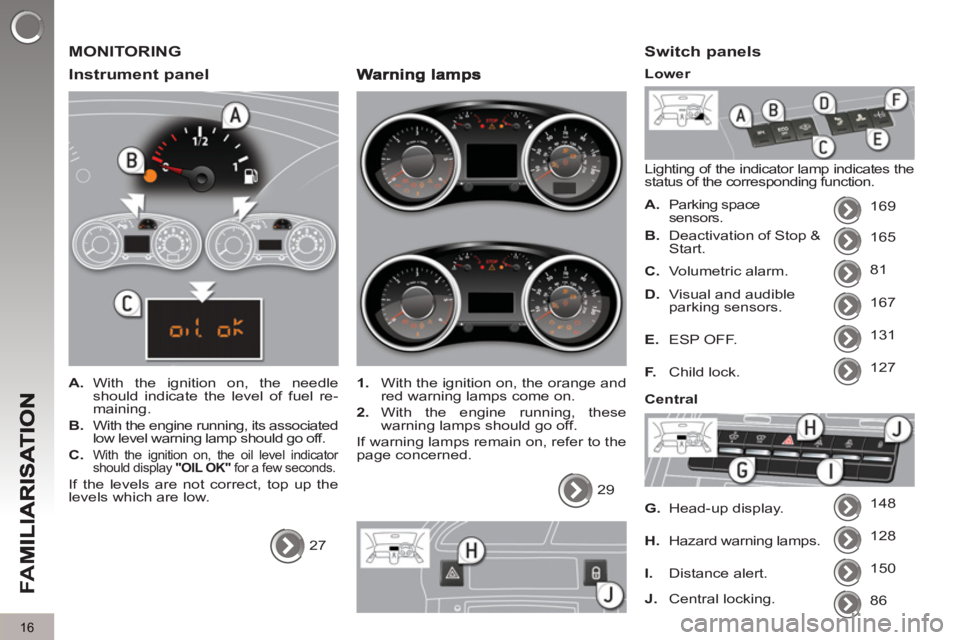
FA
M
16
MONITORING
Instrument
panel
A.
With the ignition on, the needle
should indicate the level of fuel re-
maining.
B.
With the engine running, its associated
low level warning lamp should go off.
C.
With the ignition on, the oil level indicator
should display "OIL OK"
for a few seconds.
If the levels are not correct, top up the
levels which are low.
27
1.
With the ignition on, the orange and
red warning lamps come on.
2.
With the engine running, these
warning lamps should go off.
If warning lamps remain on, refer to the
page concerned.
29
Switch panels
Lighting of the indicator lamp indicates the
status of the corresponding function.
A.
Parking space
sensors. 169
165
81
167
131
127
148
128
B.
Deactivation of Stop &
Start.
C.
Volumetric alarm.
D.
Visual and audible
parking sensors.
E.
ESP OFF.
F.
Child lock.
G.
Head-up display.
H.
Hazard warning lamps.
Lower
Central
150
I.
Distance alert.
86
J.
Central locking.
Page 28 of 340
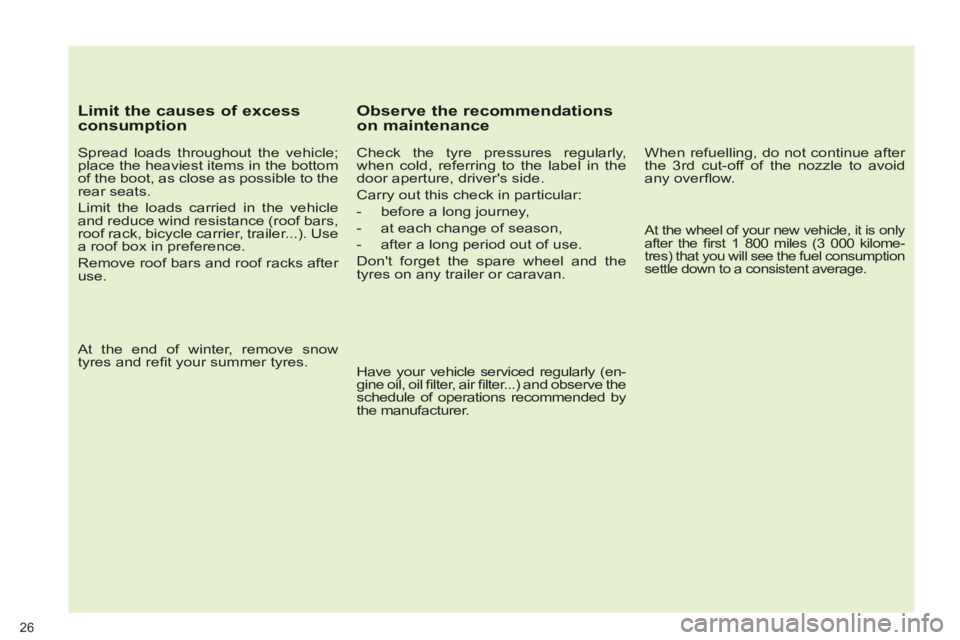
26
Limit the causes of excess consumption
Spread loads throughout the vehicle;
place the heaviest items in the bottom
of the boot, as close as possible to the
rear seats.
Limit the loads carried in the vehicle
and reduce wind resistance (roof bars,
roof rack, bicycle carrier, trailer...). Use
a roof box in preference.
Remove roof bars and roof racks after
use.
At the end of winter, remove snow
tyres and refi t your summer tyres.
Observe the recommendationson maintenance
Check the tyre pressures regularly,
when cold, referring to the label in the
door aperture, driver's side.
Carry out this check in particular:
- before a long journey,
- at each change of season,
- after a long period out of use.
Don't forget the spare wheel and the
tyres on any trailer or caravan.
Have your vehicle serviced regularly (en-
gine oil, oil fi lter, air fi lter...) and observe the
schedule of operations recommended by
the manufacturer.
When refuelling, do not continue after
the 3 rd cut-off of the nozzle to avoid
any overfl ow.
At the wheel of your new vehicle, it is only
after the fi rst 1 800 miles (3 000 kilome-
tres) that you will see the fuel consumption
settle down to a consistent average.
Page 30 of 340
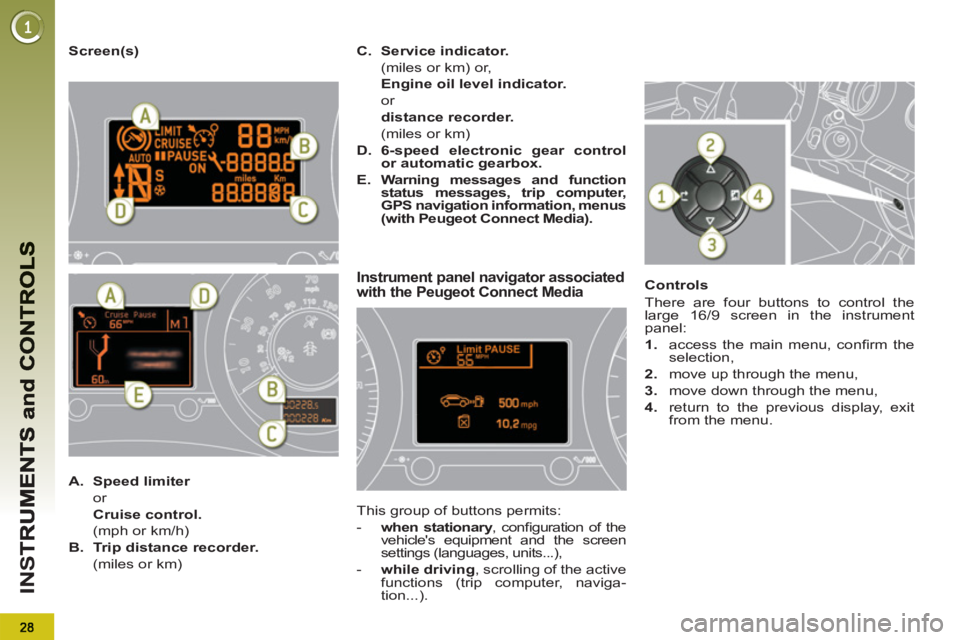
IN
S
Screen(s)
Instrument panel navigator associatedwith the Peugeot Connect Media
This group of buttons permits:
- when stationary
, confi guration of the
vehicle's equipment and the screen
settings (languages, units...),
- while driving
, scrolling of the active
functions (trip computer, naviga-
tion...).
Controls
There are four buttons to control the
large 16/9 screen in the instrument
panel:
1.
access the main menu, confi rm the
selection,
2.
move up through the menu,
3.
move down through the menu,
4.
return to the previous display, exit
from the menu.
A.
Speed limiter
or
Cruise control.
(mph or km/h)
B.
Trip distance recorder.
(miles or km)
C.
Service indicator.
(miles or km) or,
Engine oil level indicator.
or
distance recorder.
(miles or km)
D.
6-speed electronic gear control
or automatic gearbox.
E.
Warning messages and function
status messages, trip computer,
GPS navigation information, menus
(with Peugeot Connect Media).
Page 35 of 340
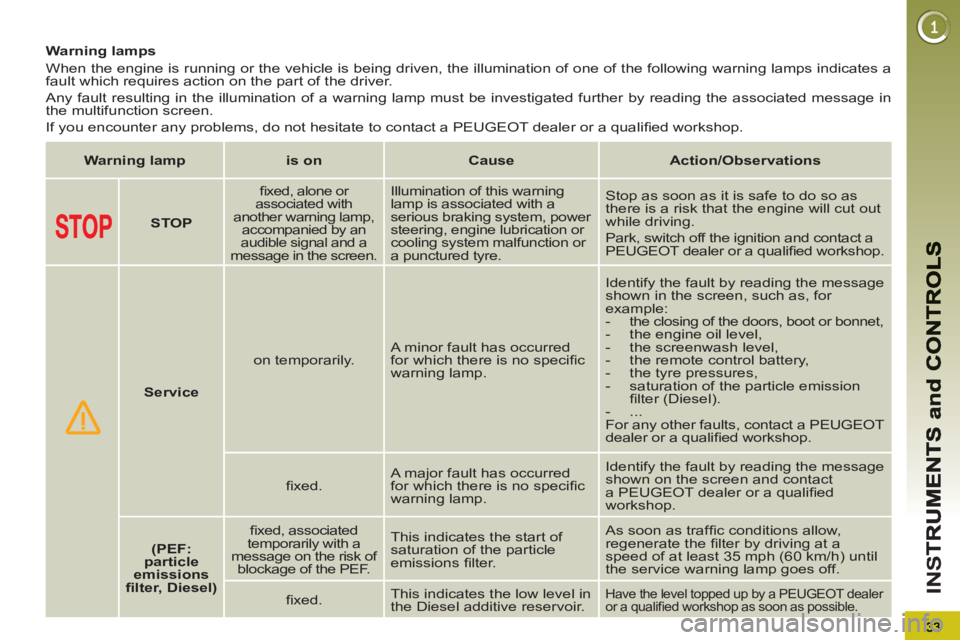
IN
S
Warning lamps
When the engine is running or the vehicle is being driven, the illumination of one of the following warning lamps indicates a
fault which requires action on the part of the driver.
Any fault resulting in the illumination of a warning lamp must be investigated further by reading the associated message in
the multifunction screen.
If you encounter any problems, do not hesitate to contact a PEUGEOT dealer or a qualifi ed workshop.
Warning lamp
is on
Cause
Action/Observations
STOP
fi xed, alone or
associated with
another warning lamp,
accompanied by an
audible signal and a
message in the screen.
Illumination of this warning
lamp is associated with a
serious braking system, power
steering, engine lubrication or
cooling system malfunction or
a punctured tyre. Stop as soon as it is safe to do so as
there is a risk that the engine will cut out
while driving.
Park, switch off the ignition and contact a
PEUGEOT dealer or a qualifi ed workshop.
Service
on temporarily. A minor fault has occurred
for which there is no specifi c
warning lamp. Identify the fault by reading the message
shown in the screen, such as, for
example:
- the closing of the doors, boot or bonnet,
- the engine oil level,
- the screenwash level,
- the remote control battery,
- the tyre pressures,
- saturation of the particle emission
fi lter (Diesel).
- ...
For any other faults, contact a PEUGEOT
dealer or a qualifi ed workshop.
fi xed. A major fault has occurred
for which there is no specifi c
warning lamp. Identify the fault by reading the message
shown on the screen and contact
a PEUGEOT dealer or a qualifi ed
workshop.
(PEF:
particle
emissions
fi lter, Diesel)
fi xed, associated
temporarily with a
message on the risk of
blockage of the PEF. This indicates the start of
saturation of the particle
emissions fi lter. As soon as traffi c conditions allow,
regenerate the fi lter by driving at a
speed of at least 35 mph (60 km/h) until
the service warning lamp goes off.
fi xed. This indicates the low level in
the Diesel additive reservoir.
Have the level topped up by a PEUGEOT dealer
or a qualifi ed workshop as soon as possible.
Page 37 of 340
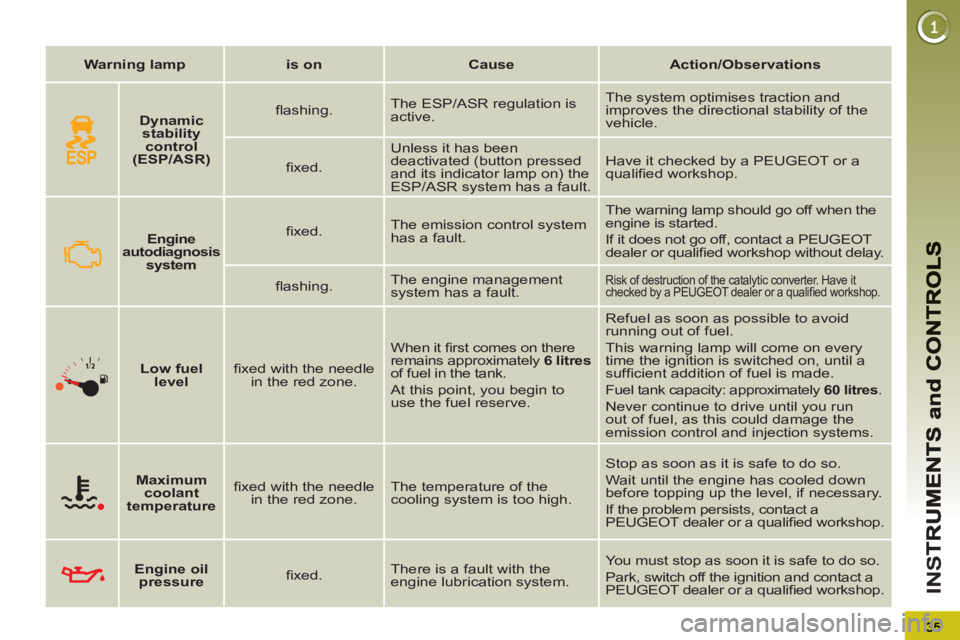
IN
S
Warning lamp
is on
Cause
Action/Observations
Engine
autodiagnosis
system
fi xed. The emission control system
has a fault. The warning lamp should go off when the
engine is started.
If it does not go off, contact a PEUGEOT
dealer or qualifi ed workshop without delay.
fl ashing. The engine management
system has a fault.
Risk of destruction of the catalytic converter. Have it
checked by a PEUGEOT dealer or a qualifi ed workshop.
Low fuel
level
fi xed with the needle
in the red zone. When it fi rst comes on there
remains approximately 6 litres
of fuel in the tank.
At this point, you begin to
use the fuel reserve. Refuel as soon as possible to avoid
running out of fuel.
This warning lamp will come on every
time the ignition is switched on, until a
suffi cient addition of fuel is made.
Fuel tank capacity: approximately 60 litres
.
Never continue to drive until you run
out of fuel, as this could damage the
emission control and injection systems.
Maximum
coolant
temperature
fi xed with the needle
in the red zone. The temperature of the
cooling system is too high. Stop as soon as it is safe to do so.
Wait until the engine has cooled down
before topping up the level, if necessary.
If the problem persists, contact a
PEUGEOT dealer or a qualifi ed workshop.
Engine oil
pressure
fi xed. There is a fault with the
engine lubrication system. You must stop as soon it is safe to do so.
Park, switch off the ignition and contact a
PEUGEOT dealer or a qualifi ed workshop.
Dynamic
stability
control
(ESP/ASR)
fl ashing. The ESP/ASR regulation is
active. The system optimises traction and
improves the directional stability of the
vehicle.
fi xed. Unless it has been
deactivated (button pressed
and its indicator lamp on) the
ESP/ASR system has a fault. Have it checked by a PEUGEOT or a
quali
fi ed workshop.
Page 42 of 340
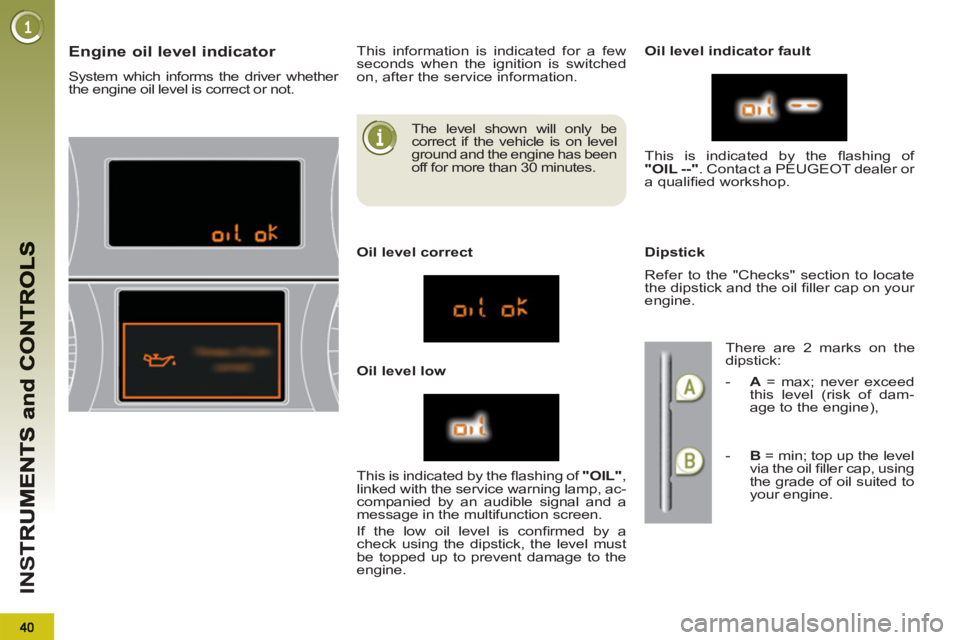
IN
S
The level shown will only be
correct if the vehicle is on level
ground and the engine has been
off for more than 30 minutes.
Engine oil level indicator
System which informs the driver whether
the engine oil level is correct or not. This information is indicated for a few
seconds when the ignition is switched
on, after the service information.
Oil level correct
Oil level low
Oil level indicator fault
Dipstick
This is indicated by the fl ashing of "OIL"
,
linked with the service warning lamp, ac-
companied by an audible signal and a
message in the multifunction screen.
If the low oil level is confi rmed by a
check using the dipstick, the level must
be topped up to prevent damage to the
engine. This is indicated by the fl ashing of
"OIL --"
. Contact a PEUGEOT dealer or
a qualifi ed workshop.
Refer to the "Checks" section to locate
the dipstick and the oil fi ller cap on your
engine.
There are 2 marks on the
dipstick:
- A
= max; never exceed
this level (risk of dam-
age to the engine),
- B
= min; top up the level
via the oil fi ller cap, using
the grade of oil suited to
your engine.
Page 92 of 340
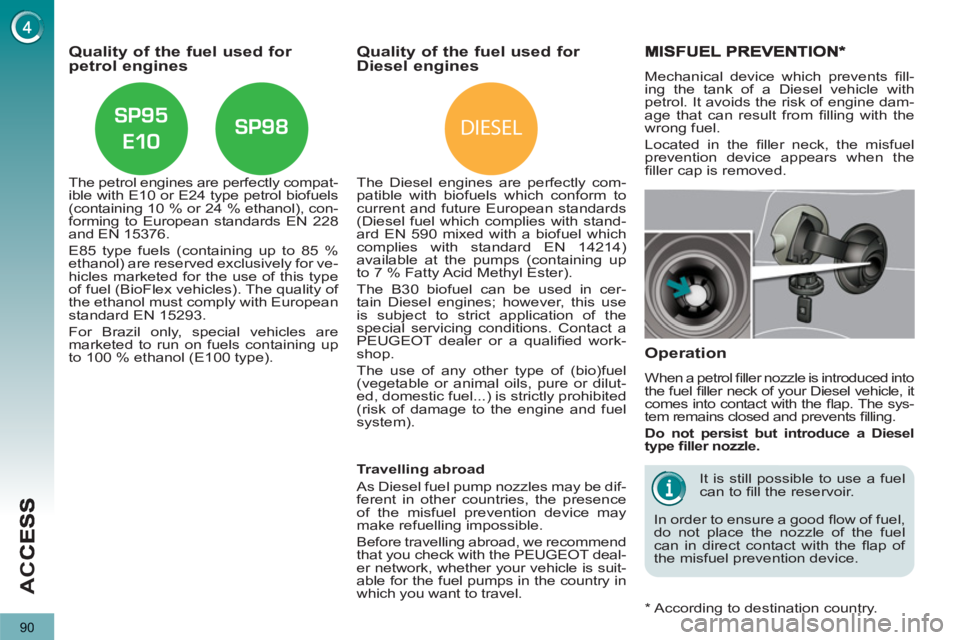
DIESEL
AC
C
90
Quality of the fuel used for petrol engines
The petrol engines are perfectly compat-
ible with E10 or E24 type petrol biofuels
(containing 10 % or 24 % ethanol), con-
forming to European standards EN 228
and EN 15376.
E85 type fuels (containing up to 85 %
ethanol) are reserved exclusively for ve-
hicles marketed for the use of this type
of fuel (BioFlex vehicles). The quality of
the ethanol must comply with European
standard EN 15293.
For Brazil only, special vehicles are
marketed to run on fuels containing up
to 100 % ethanol (E100 type).
Quality of the fuel used for Diesel engines
The Diesel engines are perfectly com-
patible with biofuels which conform to
current and future European standards
(Diesel fuel which complies with stand-
ard EN 590 mixed with a biofuel which
complies with standard EN 14214)
available at the pumps (containing up
to 7 % Fatty Acid Methyl Ester).
The B30 biofuel can be used in cer-
tain Diesel engines; however, this use
is subject to strict application of the
special servicing conditions. Contact a
PEUGEOT dealer or a qualifi ed work-
shop.
The use of any other type of (bio)fuel
(vegetable or animal oils, pure or dilut-
ed, domestic fuel...) is strictly prohibited
(risk of damage to the engine and fuel
system).
Mechanical device which prevents fi ll-
ing the tank of a Diesel vehicle with
petrol. It avoids the risk of engine dam-
age that can result from fi lling with the
wrong fuel.
Located in the fi ller neck, the misfuel
prevention device appears when the
fi ller cap is removed.
Operation
When a petrol fi ller nozzle is introduced into
the fuel fi ller neck of your Diesel vehicle, it
comes into contact with the fl ap. The sys-
tem remains closed and prevents fi lling.
Do not persist but introduce a Diesel
type fi ller nozzle.
It is still possible to use a fuel
can to fi ll the reservoir.
In order to ensure a good fl ow of fuel,
do not place the nozzle of the fuel
can in direct contact with the fl ap of
the misfuel prevention device.
Travelling abroad
As Diesel fuel pump nozzles may be dif-
ferent in other countries, the presence
of the misfuel prevention device may
make refuelling impossible.
Before travelling abroad, we recommend
that you check with the PEUGEOT deal-
er network, whether your vehicle is suit-
able for the fuel pumps in the country in
which you want to travel.
*
According to destination country.
Page 176 of 340
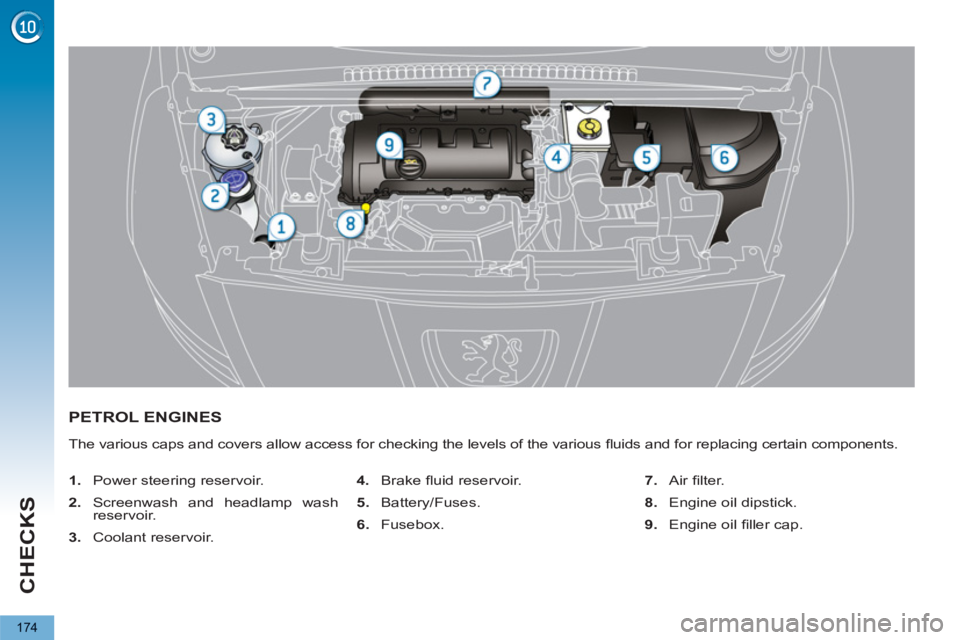
CHECKS
174
PETROL ENGINES
The various caps and covers allow access for checking the levels of the various fl uids and for replacing certain components.
1.
Power steering reservoir.
2.
Screenwash and headlamp wash
reservoir.
3.
Coolant reservoir.
4.
Brake fl uid reservoir.
5.
Battery/Fuses.
6.
Fusebox.
7.
Air fi lter.
8.
Engine oil dipstick.
9.
Engine oil fi ller cap.
Page 177 of 340
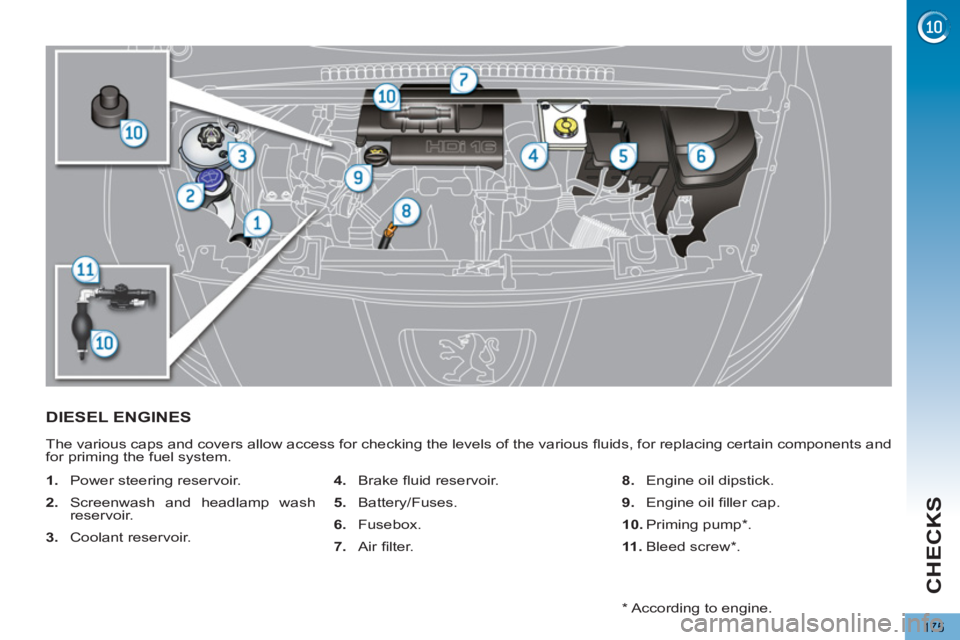
CHECKS
175
DIESEL ENGINES
The various caps and covers allow access for checking the levels of the various fl uids, for replacing certain components and
for priming the fuel system.
1.
Power steering reservoir.
2.
Screenwash and headlamp wash
reservoir.
3.
Coolant reservoir.
4.
Brake fl uid reservoir.
5.
Battery/Fuses.
6.
Fusebox.
7.
Air fi lter.
8.
Engine oil dipstick.
9.
Engine oil fi ller cap.
10.
Priming pump * .
11 .
Bleed screw * .
*
According to engine.
Page 178 of 340
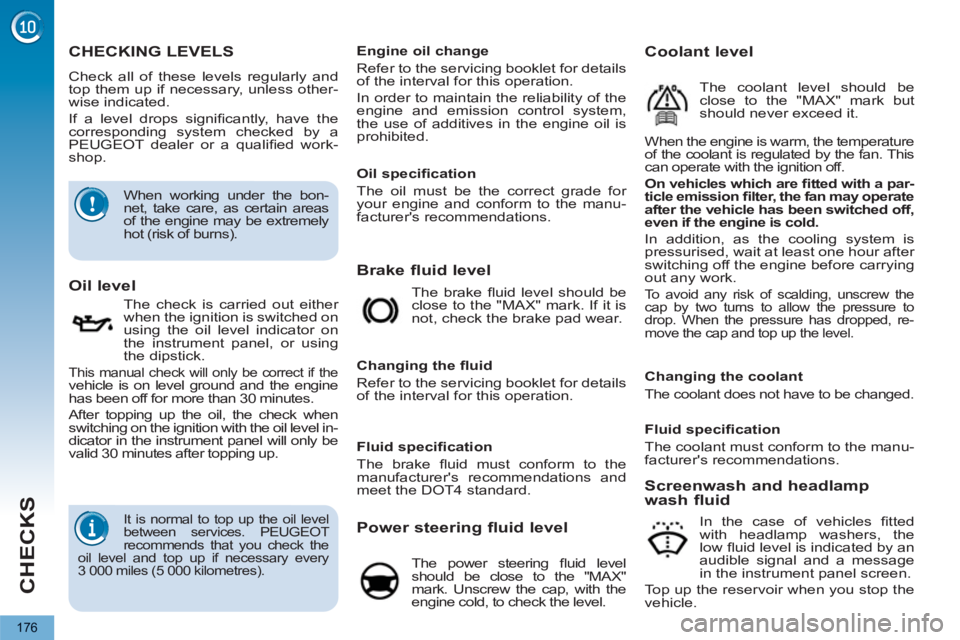
CHECKS
176
CHECKING LEVELS
Check all of these levels regularly and
top them up if necessary, unless other-
wise indicated.
If a level drops signifi cantly, have the
corresponding system checked by a
PEUGEOT dealer or a qualifi ed work-
shop.
Brake fluid level
Oil level
The check is carried out either
when the ignition is switched on
using the oil level indicator on
the instrument panel, or using
the dipstick.
This manual check will only be correct if the vehicle is on level ground and the engine
has been off for more than 30 minutes.
After topping up the oil, the check when
switching on the ignition with the oil level in-
dicator in the instrument panel will only be
valid 30 minutes after topping up. The brake fl uid level should be
close to the "MAX" mark. If it is
not, check the brake pad wear.
Changing the fl uid
Refer to the servicing booklet for details
of the interval for this operation.
Power steering fluid level
The power steering fl uid level
should be close to the "MAX"
mark. Unscrew the cap, with the
engine cold, to check the level.
Screenwash and headlamp
wash fluid
In the case of vehicles fi tted
with headlamp washers, the
low fl uid level is indicated by an
audible signal and a message
in the instrument panel screen.
Top up the reservoir when you stop the
vehicle.
Engine oil change
Refer to the servicing booklet for details
of the interval for this operation.
In order to maintain the reliability of the
engine and emission control system,
the use of additives in the engine oil is
prohibited.
Fluid specifi cation
The brake fl uid must conform to the
manufacturer's recommendations and
meet the DOT4 standard.
When the engine is warm, the temperature
of the coolant is regulated by the fan. This
can operate with the ignition off.
On vehicles which are fi tted with a par-
ticle emission fi lter, the fan may operate
after the vehicle has been switched off,
even if the engine is cold.
In addition, as the cooling system is
pressurised, wait at least one hour after
switching off the engine before carrying
out any work.
To avoid any risk of scalding, unscrew the
cap by two turns to allow the pressure to
drop. When the pressure has dropped, re-
move the cap and top up the level.
Coolant level
The coolant level should be
close to the "MAX" mark but
should never exceed it.
When working under the bon-
net, take care, as certain areas
of the engine may be extremely
hot (risk of burns).
It is normal to top up the oil level
between services. PEUGEOT
recommends that you check the
oil level and top up if necessary every
3 000 miles (5 000 kilometres).
Oil specifi cation
The oil must be the correct grade for
your engine and conform to the manu-
facturer's recommendations.
Changing the coolant
The coolant does not have to be changed.
Fluid specifi cation
The coolant must conform to the manu-
facturer's recommendations.